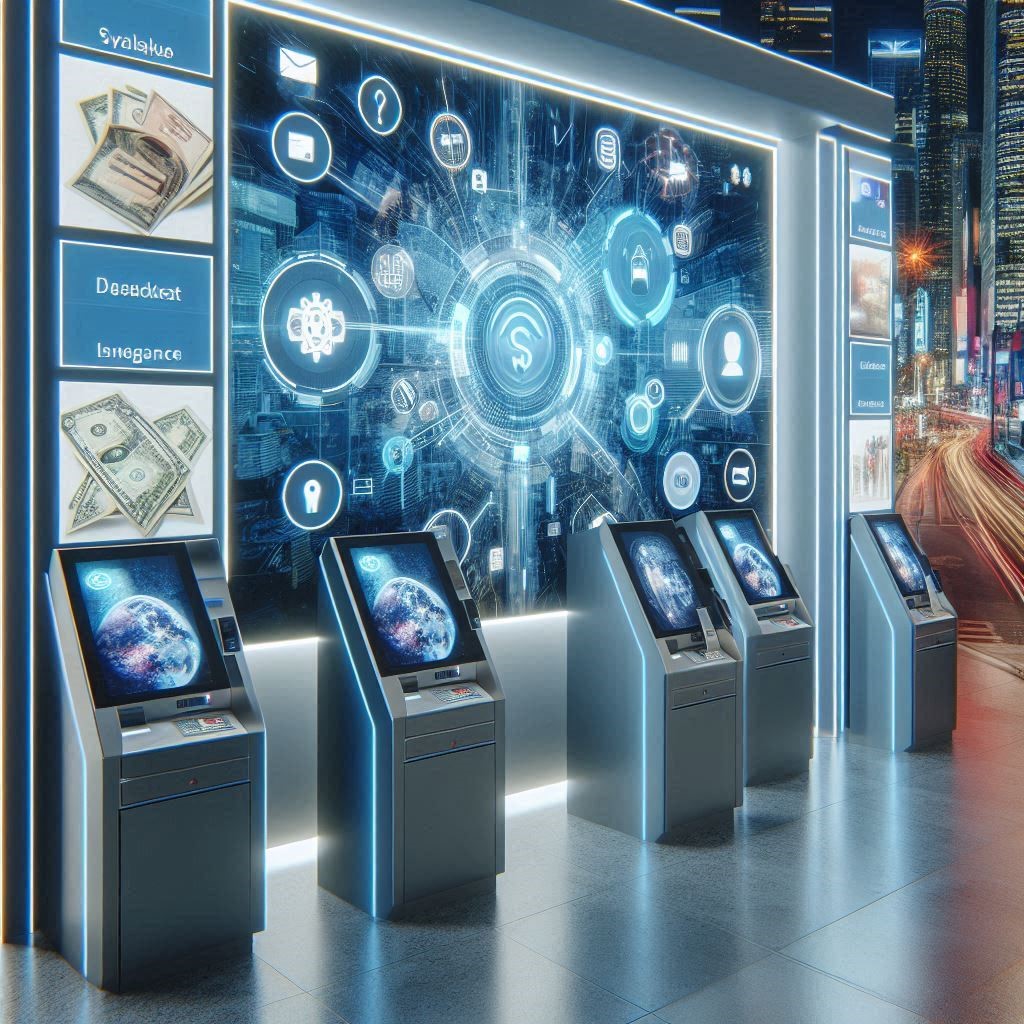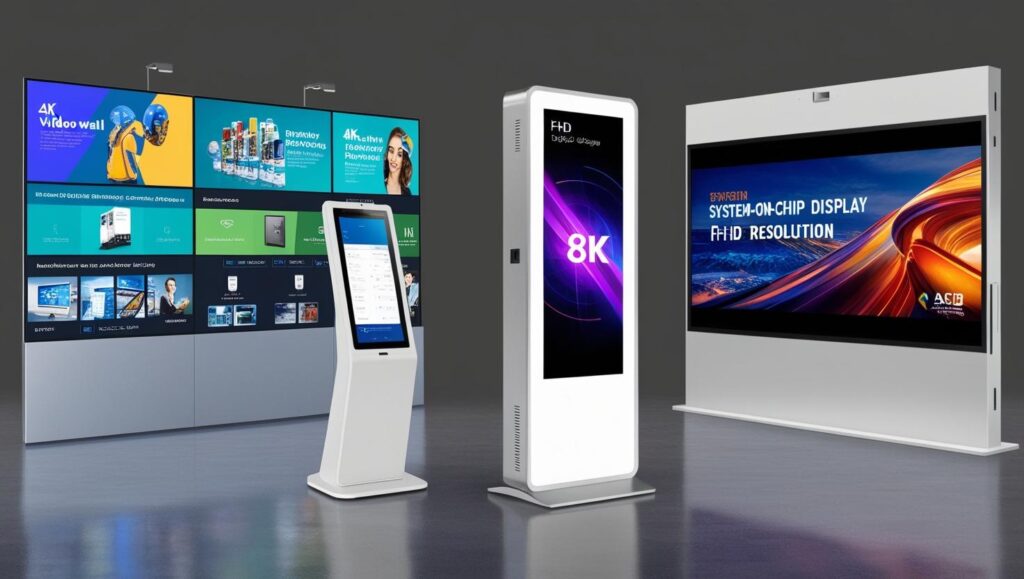The digital signage industry in the United States has experienced a significant surge in recent years, driven by advancements in display technologies, the growing demand for interactive and dynamic content, and the ongoing evolution of consumer engagement strategies. Digital signage is rapidly becoming a powerful tool for businesses and organizations across multiple sectors, offering a more engaging and effective alternative to traditional signage methods.

A New Era for Advertising and Retail
One of the primary drivers of the U.S. digital signage market is the rising demand for more dynamic advertising solutions. Traditional static billboards and posters are giving way to digital screens that allow for real-time content updates, personalized messaging, and interactive displays. This shift is particularly noticeable in retail, where businesses are increasingly using digital signage to create immersive shopping experiences and boost customer engagement.
Digital displays in retail environments are being utilized for a variety of applications, including product promotions, in-store navigation, pricing updates, and personalized offers based on customer demographics. In fact, studies show that digital signage can significantly increase impulse buying, with dynamic advertisements capturing consumers’ attention and encouraging purchases. Additionally, digital signage solutions offer businesses valuable data analytics, helping them track customer behavior and improve in-store marketing strategies.
Technological Advancements Driving Growth
Technological innovations in display technology are further fueling the growth of the digital signage market in the U.S. High-definition (HD) and 4K resolution displays, LED and OLED screens, and interactive touch displays are making digital signage more visually compelling and user-friendly. The ability to deliver high-quality, vibrant content in a variety of environments — from bright, high-traffic areas to darkened spaces — has significantly expanded the potential applications of digital signage across industries.
The integration of artificial intelligence (AI), cloud-based content management systems, and IoT devices is also enhancing the functionality of digital signage. AI allows for real-time content optimization and personalized messaging based on factors like time of day, weather conditions, and customer demographics. Meanwhile, cloud-based platforms enable easy management of multiple screens across different locations, making it easier for businesses to deploy and maintain their digital signage networks.
Digital Signage in Public Communication and Transportation
Apart from advertising and retail, digital signage is also playing a crucial role in enhancing public communication and transportation systems. In transportation hubs like airports, train stations, and bus terminals, digital signage is used for real-time flight updates, travel information, and wayfinding. The ability to deliver timely and clear communication is vital in busy transit environments, and digital signage ensures that information reaches travelers quickly and efficiently.
Public spaces, including government buildings, museums, and hospitals, are also adopting digital signage to communicate essential information to visitors. Whether it’s for public health announcements, event notifications, or emergency alerts, digital signage is becoming an indispensable tool for conveying information in real-time, especially in high-traffic locations.
Download PDF Brochure @ https://www.marketsandmarkets.com/pdfdownloadNew.asp?id=513
Key Drivers of Market Growth
The growth of the digital signage market in the U.S. is being driven by several key factors:
Enhanced Customer Engagement: Businesses are increasingly looking for ways to engage consumers through interactive and personalized experiences. Digital signage allows companies to provide targeted content and promotions that resonate with their audience.
Cost-Effective Advertising: Digital signage offers a more cost-effective and flexible alternative to traditional print advertising. Content can be updated instantly, eliminating the need for physical reprints and reducing operational costs.
Technological Advancements: Innovations in display technologies, software, and analytics are making digital signage more accessible, affordable, and easier to deploy across various industries.
Integration with IoT and AI: The integration of digital signage with IoT devices and AI-driven analytics is enabling smarter content management and more personalized consumer interactions.
Other End-User Applications of Digital Signage:
Digital signage has evolved beyond its traditional role in advertising, with a growing number of industries adopting this technology to improve communication, enhance user experiences, and boost operational efficiency. In healthcare, for instance, hospitals use digital signage to share vital patient information, assist with wayfinding, and communicate safety guidelines, while in education, universities use it to display campus news, event schedules, and real-time updates for students and faculty. Similarly, the transportation industry has embraced digital signage for real-time flight updates, wayfinding, and customer service at airports and train stations, improving the overall passenger experience.
Beyond public spaces, digital signage is also making a significant impact in sectors like hospitality, banking, and corporate offices. Hotels utilize digital signage for guest services, including check-in information, promotions, and event schedules, while financial institutions use it for product promotions and internal messaging. Corporate offices benefit from digital signage by displaying internal communications, key performance metrics, and directories, streamlining the flow of information across large organizations. The foodservice industry, too, has adopted digital signage for digital menu boards, order information, and customer engagement, particularly in fast-food chains and drive-thru operations.
As digital signage technology continues to evolve, its applications expand further, supported by advancements in interactivity and AI integration. From museums offering immersive experiences to banks promoting their services, digital signage is reshaping how businesses and institutions communicate with their audiences. With the rise of smart, connected solutions and the integration of IoT and cloud-based platforms, digital signage is poised to become even more essential in industries looking to engage, inform, and enhance experiences in real-time.

Challenges and Opportunities
Despite its rapid growth, the digital signage market does face some challenges. One of the main barriers to adoption is the upfront cost of deploying digital signage systems, especially for small and medium-sized businesses. Additionally, managing content across multiple screens and locations can be complex without the right infrastructure and expertise.
However, these challenges also present opportunities for innovation. The rise of cloud-based content management systems and subscription-based services is making it easier for businesses to deploy and maintain digital signage without significant upfront investments. Furthermore, the increasing adoption of mobile devices and the internet of things (IoT) presents opportunities for integrating digital signage with other technologies, such as mobile apps, to further enhance customer engagement.
Future Outlook
The U.S. digital signage market is expected to continue expanding, driven by ongoing technological advancements, the need for more dynamic advertising and customer engagement tools, and the growing reliance on digital communication in public spaces. As businesses across various sectors recognize the value of digital signage in enhancing customer experience and driving sales, the market is poised for continued innovation and growth.
With the increasing shift towards automation, AI integration, and personalized consumer experiences, the future of digital signage looks bright. As more industries explore the benefits of real-time, dynamic content delivery, digital signage will likely become a central component of modern communication strategies, revolutionizing the way businesses and organizations interact with their audiences.
Digital signage in the U.S. is transforming the way businesses communicate with consumers, offering new opportunities for engagement, advertising, and public communication. As technology continues to advance and more businesses realize the potential of digital signage, the market is expected to grow at an accelerated pace. With its ability to enhance the customer experience, drive sales, and improve operational efficiency, digital signage is set to become an indispensable tool in the advertising, retail, and public communication sectors.
Visit Linkedin Page : MarketsandMarkets-Semiconductor
About MarketsandMarkets™
MarketsandMarkets™ has been recognized as one of America’s Best Management Consulting Firms by Forbes, as per their recent report.
MarketsandMarkets™ is a blue ocean alternative in growth consulting and program management, leveraging a man-machine offering to drive supernormal growth for progressive organizations in the B2B space. With the widest lens on emerging technologies, we are proficient in co-creating supernormal growth for clients across the globe.
Today, 80% of Fortune 2000 companies rely on MarketsandMarkets, and 90 of the top 100 companies in each sector trust us to accelerate their revenue growth. With a global clientele of over 13,000 organizations, we help businesses thrive in a disruptive ecosystem.
The B2B economy is witnessing the emergence of $25 trillion in new revenue streams that are replacing existing ones within this decade. We work with clients on growth programs, helping them monetize this $25 trillion opportunity through our service lines – TAM Expansion, Go-to-Market (GTM) Strategy to Execution, Market Share Gain, Account Enablement, and Thought Leadership Marketing.
Built on the ‘GIVE Growth’ principle, we collaborate with several Forbes Global 2000 B2B companies to keep them future-ready. Our insights and strategies are powered by industry experts, cutting-edge AI, and our Market Intelligence Cloud, KnowledgeStore™, which integrates research and provides ecosystem-wide visibility into revenue shifts.
In addition, MarketsandMarkets SalesIQ enables sales teams to identify high-priority accounts and uncover hidden opportunities, helping them build more pipeline and win more deals with precision.
To find out more, visit www.MarketsandMarkets™.com or follow us on Twitter , LinkedIn and Facebook .
Contact:
Mr. Rohan Salgarkar
MarketsandMarkets™ INC.
1615 South Congress Ave.
Suite 103, Delray Beach, FL 33445
USA: +1-888-600-6441
Visit Our Website: https://www.marketsandmarkets.com/
